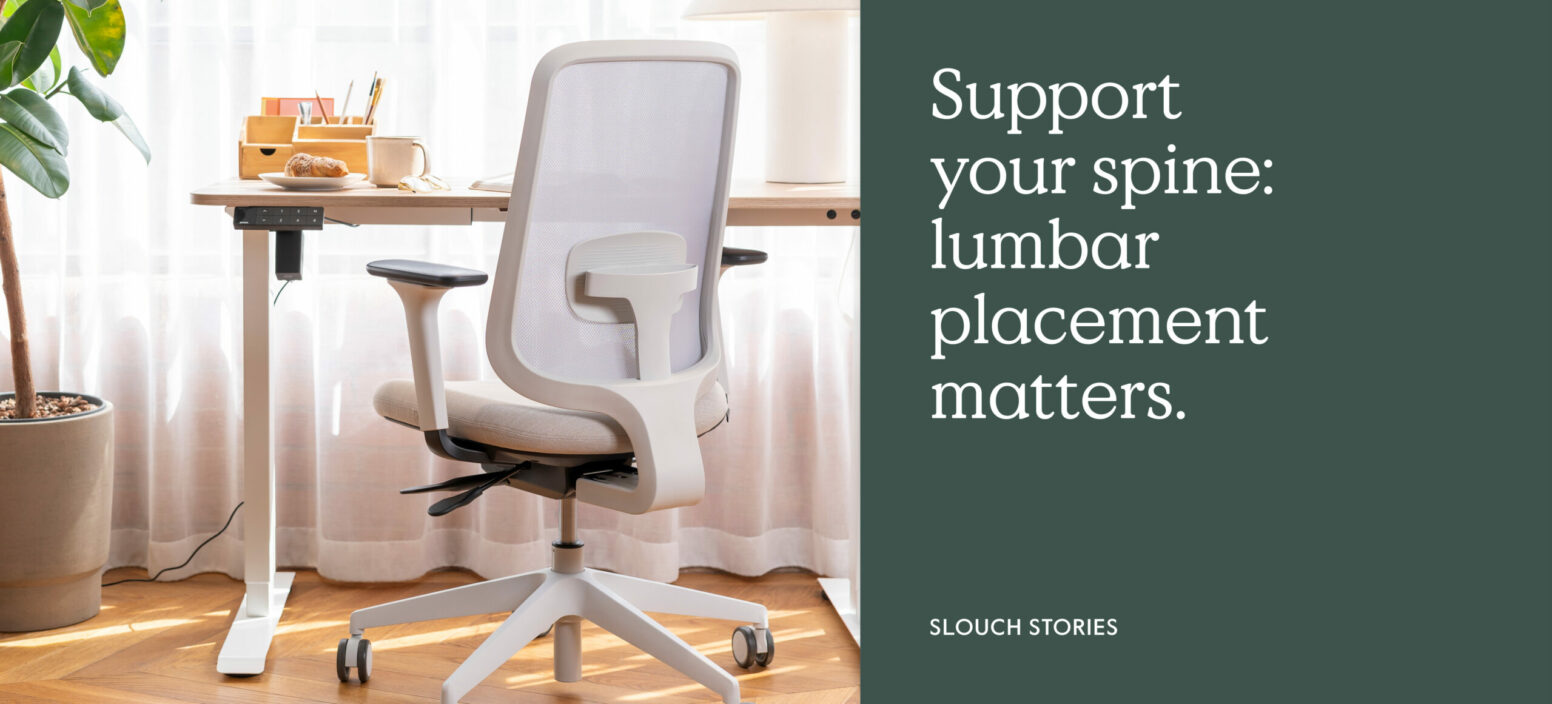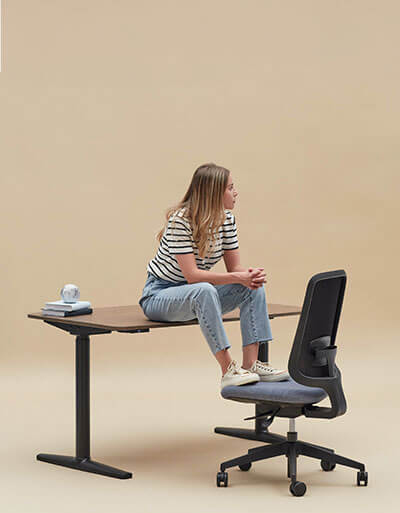Are you wondering where lumbar support should be? When we started designing ergonomic home office chairs at Slouch, we wanted to solve one of the biggest problems in the office chair market: the lack of adjustable lumbar support. Because there is a right place for it to be, and as we all have different sized and shaped bodies, this won’t automatically be in the same place on a chair for everyone.
We’ll take you through just where lumbar support should hit and why it’s so necessary to keep your back healthy. Let’s get into it.
What is lumbar support & why does it matter?
So, just what is lumbar support? While the word might sound fancy, the lumbar region is just another word for the lower part of your back. It’s made up of five vertebrae (the bones that form your spine). This area naturally curves inward, creating what’s known as the lumbar curve.
When you sit for long periods without proper support, this natural curve can flatten out. In turn, this puts strain on your back muscles and spine, leading to aches and pains.
Proper lumbar support position helps to support the natural S-shaped curve of your lower back while you’re sitting down. This reduces pressure on your spine, supports your back muscles, and helps prevent pain.
Where should lumbar support be positioned?
Now for the key question – where should lumbar support be on your chair? The answer is simpler than you might think.
It should align with the natural inward curve of your lower back, so for most people, that will be slightly above waist level, in the small of the back.
To find the perfect height:
- Sit all the way back in your chair with your bottom against the backrest
- Place one hand behind your back and feel for the inward curve just above your belt line
- Adjust your chair’s lumbar support to match this exact spot
Be sure to follow the advice above because if your lumbar support is near your mid-back or shoulder blades, it’s too high, but if it’s below your waistline, it’s too low. In both cases, this won’t maintain your spine’s natural curve.
Getting the right depth and pressure
The depth of the lumbar support is another key part of positioning it correctly and is just as important as getting the right height.
It should fill the gap between the chair’s backrest and your lower back’s natural curve.
The right depth means:
- You feel supported without being pushed forward
- The curve feels natural, not forced
- There’s no uncomfortable pressure on any part of your back
For chairs with adjustable depth, start with a gentle support and gradually increase until you find what feels most comfortable for your body.
The proven benefits of lumbar support
The World Health Organisation estimates that 619 million people live with lower back pain and that it’s a leading cause of disability worldwide. So it’s well worth addressing one of the clear and controllable causes, poor lumbar support position.
Here’s what else you could stand to benefit from when you use lumbar support.
Reduced lower back pain
The idea is that lower back support means your spinal discs are properly braced and aren’t compacted. This reduced pressure means less chance of aches by the end of the day.
In fact, many office workers find that their lower back pain is dramatically reduced as soon as they start using lumbar support, just like Nicola, who said this in a Trustpilot review of her new Slouch chair:
“After years of hand me down office chairs, and lately suffering with terrible lower back pain. I decided that it was time to upgrade. I researched and found Slouch, researched Slouch and decided to give it a go.
I got the forward seat tilt and no arms, I’ve had it a week and no more back pain!! My husband and I have our own business, so I could be sat in my office chair all day and all night sometimes. I would definitely recommend”
- Nicola Watson, Truspilot
Improved Posture and Alignment
Without proper back support, it’s tempting to hunch over forward, or dare we say it, slouch. That means strain on both the back and neck. Giving more structure to how you sit encourages better posture and correct alignment of your shoulders, hips and pelvis.
Better circulation and less fatigued muscles
Remember how we were saying that slumping over puts pressure on your spine? Well, an unfortunate knock-on effect is that it compresses the blood vessels in your back and legs.
Getting your lumbar positioning right opens up these pathways again, meaning unrestricted blood flow that gets more oxygen to your muscles. That sluggish feeling and ache in your muscles will be history.
No more distractions from discomfort
It might sound obvious, but when you’re in discomfort, you’re likely being held back from uninterrupted focus. Make sure your workplace is working for you with seating that means you can lock into the task at hand without nagging pain.
The different kinds of lumbar support
If you’re now more convinced by the benefits of adding some much-needed cushioning to your lower back, here are the main types you’ll find in modern office desks.
Fixed lumbar support
Fixed supports are built directly into the chair’s backrest, but they can’t be moved, so they’re in the same position whether you’re 5’2” or 6’4”. See the potential issue? They tend to be less expensive and act as an entry-level option that can provide some support if it happens to hit your back in the right place, as we’ve discussed above.
External lumbar support
If your current chair lacks proper support, external lumbar cushions are an option that you can add to up your comfort. They normally attach to your chair with straps and can be an affordable option to consider. The downside is that they’re likely to need readjusting throughout the day as they’re known for wiggling around.
You’ll often see this kind of cushion included in gaming chair set-ups. Check out our guide on gaming chairs vs office chairs if you’re been considering this option.
Adjustable lumbar support
This is the best option. Adjustable lumbar support can be modified in one or both of these ways:
- The height of the support (moving it up or down)
- The depth or firmness (adjusting how far it extends into your back)
Quality ergonomic chairs, like those in Slouch’s collection, feature fully adjustable lumbar support that can be tailored to your exact needs. It also makes it one of the best office chairs for sciatica, as the tailored cushioning prevents compression on the spine.
Does your back need more support? The warning signs
Wondering if your chair is doing enough to keep your body happy? Here are the signs to watch out for that let you know it’s time to upgrade your seating support:
- Persistent lower back pain after sitting
- Feeling the need to frequently shift position
- Numbness or discomfort in your legs
- Neck or shoulder pain (normally caused by compensating for poor lower back support)
- Finding yourself slouching forward regularly
- Sitting on the edge of your chair rather than using the backrest
- Hunching your shoulders or leaning to one side
- Regularly getting up due to discomfort
If these sound familiar, it might be time to make a change for the sake of your body.
Curious what else can improve your office ergonomics?
Getting the right lumbar support position is just the start of the different ways you can make working life more comfortable. If you want to know how to set up a home office so that it properly takes care of your body, here are some top things to consider.
- Seat depth and chair height: Your chair height should allow your feet to rest flat on the floor with your knees at roughly a 90-degree angle. The seat depth should let you sit all the way back with a small gap (about the width of your fist) between the edge of the seat and the backs of your knees.
- Armrest positioning: If your chair has armrests, adjust them so your shoulders remain relaxed and your elbows form approximately 90-degree angles when typing.
- Desk and monitor height: Your desk should be at a height where your forearms are parallel to the floor when typing. Your monitor should be at eye level, about an arm’s length away, to prevent neck strain.
- Movement throughout the day: Even with perfect lumbar support, staying in one position for too long can cause discomfort. Take short standing breaks every 30-60 minutes, change your sitting position occasionally, and consider a height-adjustable desk to alternate between sitting and standing.
Ready to make your office better for your body? We’ve got everything you need. Shop powerfully designed ergonomic desk chairs and height adjustable desks today.

